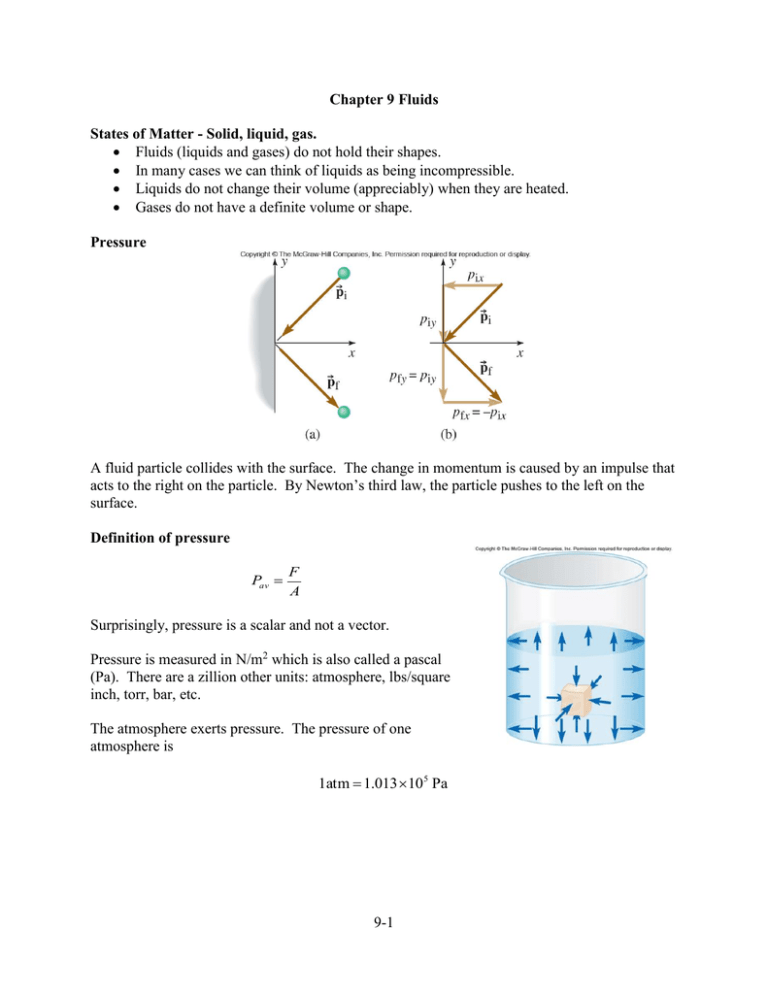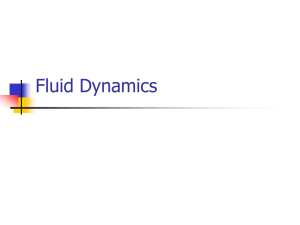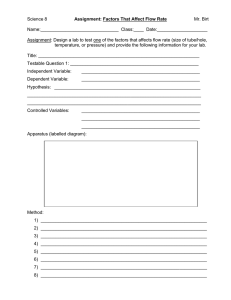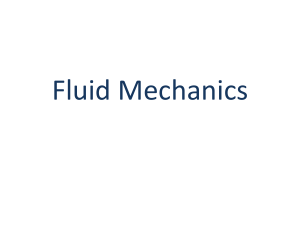Fluids (liquids and gases) do not hold their shapes.
advertisement

Chapter 9 Fluids States of Matter - Solid, liquid, gas. Fluids (liquids and gases) do not hold their shapes. In many cases we can think of liquids as being incompressible. Liquids do not change their volume (appreciably) when they are heated. Gases do not have a definite volume or shape. Pressure A fluid particle collides with the surface. The change in momentum is caused by an impulse that acts to the right on the particle. By Newton’s third law, the particle pushes to the left on the surface. Definition of pressure Pav F A Surprisingly, pressure is a scalar and not a vector. Pressure is measured in N/m2 which is also called a pascal (Pa). There are a zillion other units: atmosphere, lbs/square inch, torr, bar, etc. The atmosphere exerts pressure. The pressure of one atmosphere is 1atm 1.013 105 Pa 9-1 Pascal’s Principle “A change in pressure at any point in a confined fluid is transmitted everywhere throughout the fluid.” (p. 320) Pascal’s principle is a consequence of the incompressibility of fluids. Pascal’s principle is the basis of hydraulics. Hydraulics are the most effective way to transmit a force. Notice that the displacement in the narrow tube is much greater that the displacement in the wide tube. We will return to this observation later. The force on the right (F1) changes the pressure in the fluid. By Pascal’s principle, the change in pressure is transmitted throughout the fluid. P1 P2 F1 F2 A1 A2 A F2 2 F1 A1 If A2>A1, then the F2>F1. Modern Marvels: https://www.youtube.com/watch?v=74VEL22U_0o Excavator advertisement: https://www.youtube.com/watch?v=VBMUvAUPTGM 9-2 Density is the mass per unit volume. It is defined as m V Density is measured in kg/m3. As we descend down into a fluid the amount of fluid above us increases. That additional fluid pushes down and the pressure increases with depth. At depth d the pressure has increased P2 P1 gd Measuring Pressure A manometer consists of a U-shaped tube containing some mercury. When both sides are open to the atmosphere, the height in both arms are the same. When one side is connected to the pressure to be measured, the heights are different. The pressures at B and B' are the same, PB PC gd 9-3 Usually, the manometer is open to the atmosphere. It will measure pressures relative to atmospheric. The gauge pressure is the pressure relative to an atmosphere. Pgauge Pabs Patm “Blood pressure is measured with a sphygmomanometer. The oldest kind of sphygmomanometer consists of a mercury manometer on one side attached to a closed bag—the cuff. The cuff is wrapped around the upper arm at the level of the heart and is then pumped up with air. The manometer measures the gauge pressure of the air in the cuff. “At first, the pressure in the cuff is higher than the systolic pressure—the maximum pressure in the brachial artery that occurs when the heart contracts. The cuff pressure squeezes the artery closed and no blood flows into the forearm. A valve on the cuff is then opened to allow air to escape slowly. When the cuff pressure decreases to just below the systolic pressure, a little squirt of blood flows past the constriction in the artery with each heartbeat. The sound of turbulent blood flow past the constriction can be heard through the stethoscope. “As air continues to escape from the cuff, the sound of blood flowing through the constriction in the artery continues to be heard. When the pressure in the cuff reaches the diastolic pressure in the artery—the minimum pressure that occurs when the heart muscle is relaxed—there is no longer a constriction in the artery, so the pulsing sounds cease. The gauge pressures for a healthy heart are nominally around 120 mm Hg (systolic) and 80 mm Hg (diastolic).” (p. 327) Buoyant Force When an object is submerged in a fluid, the fluid pushes up on the object. The buoyant force is given by FB gdA gV Archimedes’ principle A fluid exerts an upward buoyant force on a submerged object equal in magnitude to the weight of the volume of fluid displaced by the object. 9-4 We still need to use free body diagrams! The force F1 is the force of the fluid above the block pushing down and the force F2 is the force of the fluid below the block pushing up. The buoyant force is FB F2 F1 FBy F2 y F1 y FB F2 F1 The specific gravity is defined as the ratio of the density of the material to the density of water. S.G. water If S.G. < 1, the object will float. If S.G. > 1, the object sinks. Archimedes and the golden crown: http://www.youtube.com/watch?v=hIYdxQuzb60 The story: http://longlongtimeago.com/once-upon-a-time/great-discoveries/eureka-the-story-ofarchimedes-and-the-golden-crown/ We have completed our study of fluids at rest. Now we consider fluids in motion. Fluid Flow A fluid moving past a surface can exert a viscous force against the surface. This is similar to the frictional force of an object sliding over a surface. We will start by assuming the viscous force to be small. When flow is steady, the velocity at any point is constant in time. The flow may not be the same everywhere. Steady flow is laminar. The streamlines are clearly defined. As we have done many times this semester, we assume the ideal case first. An ideal fluid is incompressible, undergoes laminar flow, and has no viscosity. 9-5 The continuity equation Since the fluid is incompressible, the fluid flows faster in the narrow portions of the pipe. The mass flow rate is defined as m Av t The volume flow rate is V Av t The continuity equation for an incompressible fluid equates the volume flow rates past two different points, A1v1 A2v2 The continuity equation is a consequence of conservation of mass. Bernoulli’s Equation Using energy ideas, the pressure of the fluid in a constriction cannot be the same as the pressure before or after the constriction. For horizontal flow the speed is higher where the pressure is lower. This is called the Bernoulli effect. “The Bernoulli effect can seem counterintuitive at first; isn’t rapidly moving fluid at high pressure? For instance, if you were hit with the fast-moving water out of a firehose, you would be knocked over easily. The force that knocks you over is indeed due to fluid pressure; you would justifiably conclude that the pressure was high. However, the pressure is not high until 9-6 you slow down the water by getting in its way. The rapidly moving water in the jet is, in fact, approximately at atmospheric pressure (zero gauge pressure), but when you stop the water, its pressure increases dramatically.” (p. 334) For a more general situation where the pipe is not horizontal, we can use energy considerations to derive Bernoulli’s equation. (The derivation is given on page 335. I will only quote the result.) P1 gy1 12 v1 P2 gy2 12 v2 2 2 or P gy 12 v 2 constant Hopefully, this reminds you of Wnc mgy1 12 mv1 mgy2 12 mv2 2 2 Bernoulli’s equation relates the pressure, flow speed, and height at two points in an ideal fluid. Problem 50. Suppose air, with a density of 1.29 kg/m3 is flowing into a Venturi meter. The narrow section of the pipe at point A has a diameter that is 1/3 of the diameter of the larger section of the pipe at point B. The U-shaped tube is filled with water and the difference in height between the two sections of pipe is 1.75 cm. How fast is the air moving at point B? Strategy Use the continuity equation to relate the speeds at points A and B. Then, use Bernoulli’s equation to find the speed of the air at point B. Solution Relate the air speeds at points A and B. AB vB AAv A , so v A AB d B2 vB vB 9vB . AA (d B 3)2 y A yB . Find the speed of the air at point B. Note that PB 12 v B gy B PA 12 v A gy A 2 2 PB 12 v B PA 12 v A 2 1 2 2 v B 2 PA PB 12 (9v B ) 2 9-7 1 2 v B 2 PA PB 812 v B 2 40 v B PB PA 2 The pressure difference causes the height difference in the manometer PB PA W gh Substituting 40v B W gh 2 vB W gh 40 (1000 kg/m 3 )(9.8 m/s 2 )(1.75 10 2 cm ) 40(1.29 kg/m 3 ) 1.82 m/s Problem 46. In a tornado or hurricane, a roof may tear away from the house because of a difference in pressure between the air inside and the air outside. Suppose that air is blowing across the top of a 2000 ft2 roof at 150 mph. What is the magnitude of the force on the roof? P1 P2 Strategy Use Bernoulli’s equation to find the pressure difference at the roof. Solution Let the region above the roof be labeled 1. The region inside the house near the roof is labeled 2. Assume the air under the roof is still. P1 12 v1 gy1 P2 12 v2 gy2 2 2 P1 12 v1 gy1 P2 gy2 2 Now y1 is almost equal to y2 and we can assume that the difference in height has negligible effect on the pressure. P1 12 v1 P2 2 P2 P1 12 v1 9-8 2 Which side is at the higher pressure, the inside or outside? The magnitude of the force on the roof is 1 v 2A 2 air 1 2 2 2 2 1 150 mi 1 h 1609 m 2 1 m 5.0 105 N . (1.20 kg m3 ) (2000 ft ) 2 1 h 3600 s 1 mi 3.281 ft F PA which is equal to 56 tons! Viscosity Bernoulli’s equation ignores viscosity. When real fluids flow, the different layers of fluid drag against each other. A pressure difference is needed to maintain the flow. This is similar to needing a constant force to overcome kinetic friction. Fluid layers further away from the wall flow faster than those close to the wall. Poiseuille’s Law The volume flow rate of viscous fluid through a horizontal cylindrical pipe depends on Pressure gradient P L Viscosity. The higher the viscosity, the lower the flow rate. Radius of the pipe. The French physician Poiseuille (pwahzoy) formulated his law after studying blood flow V P / L 4 r t 8 Viscosity is (Greek letter eta), measured in Pas. Other units are poise (pwaz) (P) and cP. Conversions are 1 P = 0.1 Pas and 1 cP = 0.001 Pas. Problem. Water flows through a pipe of radius 8.50 mm. The viscosity of water is 1.005 cP. If the flow speed at the center is 0.200 m/s and the flow is laminar, find the pressure drop due to viscosity along a 3.00 m section of pipe. Strategy Use Poiseuille’s Law to find the pressure drop. 9-9 Solution Poiseuille’s law is V P / L 4 r t 8 Solving for P P V 8 L t r 4 The volume flow rate is related to the area of the tube and the speed of the flow (see the continuity equation) V Av r 2v (8.50 103 m) 2 (0.200 m/s ) 4.54 105 m3 /s t Viscosity is not in the correct units. = 1.005×10-3 Pas. The pressure difference is P V 8 L 8 (1.005 103 Pa s)(3 m) 5 3 ( 4 . 54 10 m /s) 67 Pa t r 4 (8.50 103 m) 4 Turbulence Turbulence is unsteady fluid flow, not laminar flow. In turbulent flow, swirling vortices appear. The vortices are not stationary and they move with the fluid. The velocity of the fluid flow can change direction and magnitude in an uncontrolled way. Why do golf balls have dimples? From HowStuffWorks.com: The reason why golf balls have dimples is a story of natural selection. Originally, golf balls were smooth; but golfers noticed that older balls that were beat up with nicks, bumps and slices in the cover seemed to fly farther. Golfers, being golfers, naturally gravitate toward anything that gives them an advantage on the golf course, so old, beat-up balls became standard issue. 9-10 At some point, an aerodynamicist must have looked at this problem and realized that the nicks and cuts were acting as “turbulators” – they induce turbulence in the layer of air next to the ball (the “boundary layer”). In some situations, a turbulent boundary layer reduces drag. If you want to get deeper into the aerodynamics, there are two types of flow around an object: laminar and turbulent. Laminar flow has less drag, but it is also prone to a phenomenon called “separation.” Once separation of a laminar boundary layer occurs, drag rises dramatically because of eddies that form in the gap. Turbulent flow has more drag initially but also better adhesion, and therefore is less prone to separation. Therefore, if the shape of an object is such that separation occurs easily, it is better to turbulate the boundary layer (at the slight cost of increased drag) in order to increase adhesion and reduce eddies (which means a significant reduction in drag). Dimples on golf balls turbulate the boundary layer. The dimples on a golf ball are simply a formal, symmetrical way of creating the same turbulence in the boundary layer that nicks and cuts do. Baseball: http://www.youtube.com/watch?v=oph9BP4lKjs Magnus effect. Tennis: top spin, slice, side spin; Baseball: curveballs; Golf: slice, hook http://www.youtube.com/watch?v=Fk2xU8pEIlI&index=2&list=PLB0A49B27192A26D5 Viscous Drag An object moving through a fluid experiences drag. Clearly the drag depends on the viscosity of the fluid, the speed of the object, and its size. Viscous drag is very complicated, but there is a well understood example. For a sphere of radius r traveling at appropriate speed v (so there is no turbulence), Stoke’s Law holds FD 6rv When the viscous drag is equal to a falling object’s weight, the object reaches terminal velocity. This is how parachutes work. Surface Tension The surface of a liquid has special properties not associated with the interior of the liquid. The surface acts like a stretched membrane under tension. The surface tension () of a liquid is the force per unit length with which the surface pulls on its edge. Soaps break up the surface tension so that water can reach into small places and clean them. 9-11 “The high surface tension of water is a hindrance in the lungs. The exchange of oxygen and carbon dioxide between inspired air and the blood takes place in tiny sacs called alveoli, 0.05 to 0.15 mm in radius, at the end of the bronchial tubes. If the mucus coating the alveoli had the same surface tension as other body fluids, the pressure difference between the inside and outside of the alveoli would not be great enough for them to expand and fill with air. The alveoli secrete a surfactant that decreases the surface tension in their mucous coating so they can inflate during inhalation.” (p. 344) Bubbles A gas bubble inside a fluid is in equilibrium between the surface tension trying to shrink the bubble and the pressure inside trying to expand it. The pressure inside the bubble must be greater than the fluid pressure outside. It can be shown that the pressure difference, P, is P Pin Pout 2 r As the bubbles rise to the surface from the bottom, they expand. Pin reduces with the expansion and r increases as well. The difference, Pin−Pout, becomes smaller. 9-12





